Iconography
Iconography (Stone Sculptures) Although Bangla had no stone quarry of an appreciable size to provide the sculptors enough material to realise their aesthetic ambitions, a large number of stone sculptures of high artistic quality and iconographic interest were produced in Bengal, especially in the period between the 9th to 13th centuries AD. The greyish black stone known as Rajmahal slate was quarried from the Rajmahal Hills of the Purnia district of Bihar and exported to Bengal.
Hindu Sculptures The earliest Hindu stone sculptures of Bengal originated in the late Kusana period (3rd-4th century AD). With the stone sculptures we have to include, no doubt, a few terracotta sculptures which are of great interest, such as the four-armed Mahisamardini figure from Sarsabaz (Bogra), now in the Mahasthan Museum. This is the most magnificient early image of the deity not only from Bengal but from the Indian Subcontinent. (Fig-1) Perahps this unique image clearly points to the reason why the goddess Durga-Mahismardini became so prominent and popular in Bengal and has maintained the same status even up to this age.

Male Divinities 'prominent and popular Hindu male deities were Brahma, Visnu, Surya, Shiva and Ganesha. Brahma 'Surprisingly, Brahma, who was a minor deity in the rest of the Indian subcontinent, enjoyed popularity in Bengal. Several stone images of the deity bear evidence to this fact.
An earlier form of Brahma with three heads (shown in relief) but two arms (this is the description of the 6th century text Brhatsanghita), seated on a plain pedestal (the lotus is still missing from the pedestal) holding perhaps a rosary (aksamala) in the right hand (damaged) and a water-jar (kamandalu) in the left, comes from Bhadrakali (Hughli, West Bengal), and is now in the Asutosh Museum, Calcutta.
A small duck (hangsa) has been shown below the left foot of the deity. The image should be dated in the 8th-9th century. (Fig-2) A terracotta plaque from the first terrace of the Paharpur temple also shows a Brahma of this type.
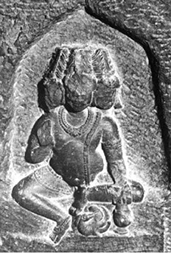
The Puranas, however, frequently describe Brahma with four heads and four arms. A fully developed form of Brahma with four heads (three shown in relief), four arms and with beard and moustache, is seen in the seated 11th-12th century Brahma image from Dinajpur district, now in the Dinajpur Museum of Bangladesh.
(Fig-3) In the four hands the deity holds clockwise the rosary (aksamala), the sacrificial ladle (shruk), a second sacrificial spoon (sruva) and a waterjar (kamandalu). The deity sits on a double-petalled lotus, with a small lotus below his right foot. A duck is shown with two devotees on the pedestal. Brahma is accompanied by two four-armed seated female divinities, perhaps Savitri and Sarasvati. Kirtimukha is shown on top with two Vidyadharas. Later forms of Brahma are also shown without beard and moustache.
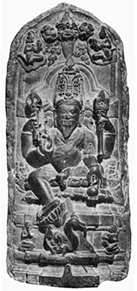
Ganesha After Brahma, a minor but popular Hindu deity of Bengal is the elephant-headed Ganesha, who is shown seated or standing, but a delightful form of the god shows him dancing, and this form of Ganesha from Bengal excels the forms of the deity from other parts of the subcontinent. Ganesha appears as an independent deity, but sometimes he is shown with Lalita (a special form of Parvati), with Gauri and child Shiva, with the Matrkas (Mother goddesses) and with the Navagrahas (nine planetary deities). Ganesha appears also in the Buddhist context in the paharpur temple and halud vihara in Bangladesh.
The most graceful form of the seated Ganesha is from Mandhuk (Comilla), now in the Mainamati Museum. The image is inscribed and belongs to the first regnal year, perhaps of Gopala II (c 9th century).
The deity sits in a position called royal ease (maharaja-lila) holding clockwise in his four hands a fruit (matulunga or bijapura), a radish with leaves (mulaka), a bowl of sweets (modaka-bhanda) and a battle-axe (parashu).

The radish is a special attribute of Ganesha images from Bihar-Bengal. A snake forms the sacred thread (yajnopavita) of the deity, and a playful rat (musika) is shown as his mount (vahana) on the pedestal. The second most important and interesting seated image of Ganesha is from Narayanpur (Comilla), now in the bangladesh national museum (BNM), Dhaka, and is dated in the 4th regnal year of the Pala ruler mahipala i (c 11th century). (Fig-4) The large, beautiful image holds clockwise in his four hands a rosary (aksmala), a radish with leaves (mulaka), a battle-axe (paraxu) and a pot of sweets (modaka-bhanda). On top bunches of mangoes are shown with leaves, a special feature of the Ganesha images from Benagal. The rat (musika) is shown below his right foot.
A unique form of a five-headed image of Ganesha seated on a roaring lion comes from Rampal (Munshiganj), but its present whereabouts are not known. The deity, dated in the 12th century, is ten-armed of which a few attributes are damaged. Six seated Ganeshas are shown on the back-plate above the flying Vidyadharas. This unique type of Ganesha has been called Heramba-Ganapati by Bhattasali following the dhyana given in the xaradatilaka. The graceful dancing form of Ganesha, called Nrtya-Ganapati, is a masterly creation of the Bengali sculptors. The dancing Ganeshas either have six or eight arms and they are accompanied by two musicians, Go-karna (having the ears of a cow) and Gaja-karna (having the ears of an elephant). A dancing Ganesha is shown either on a lotus or on a rat.
An eleventh century image, from North Bengal, of the eight-armed dancing deity on a rat is in the collection of the Museum of Indian Art in Berlin. The deity holds clock-wise: abhaya-mudra, a rosary, the battle-axe, his broken right tusk, nrttya-hasta, a blue lily (utpala), a snake and a pot of sweets. The two musicians, Gaja-karna and Go-krana dance while playing cymbals and drum. The spotted rat watches the dance of the Lord with wonder.
Visnu' Of all the male Hindu deities Visnu was most popular in Bengal. Haque has listed nearly 815 images of Visnu and Vaisnavite deities, mostly of stone. The different varieties of Visnu images in Bengal and their gradual development need a special and careful study. Of the earlier images of Visnu mention may be made of the images from Hankrail (Rajshahi), now in the varendra research museum (VRM), Rajshahi, and from Narhatta (Bogra), now in VRM. The four arms of the deity are not raised above, the back right and the left arms are lowered and the hands hold a mace (gada) and a disk (chakra) respectively, the upper right hand holds a fruit (matulunga or bijapura), and the upper left hand a conch (Shankha), the spiral of which is always shown upwards in Bengal. Garuda, the vehicle of Visnu, does not appear at this early stage.
In the next stage the two attributes, viz. gada and chakra, are personified as Gadadevi as well as Chakrapurusa. One may compare the following images: Visnu from Shib-bari (West Dinajpur), now in the State Archaeological Gallery, Calcutta, Visnu from Karaicharchar (Dinajpur), in VRM, also Visnu from Khiarmamudpur (Dinajpur), in BNM. In this group belongs the Chaitanpur (Burdwan) Visnu image, now in the Indian museum ,Calcutta. One should remember that the early Visnu images from Bengal do not hold a lotus (padma); therefore it is not proper to arrange the Visnu images from Bengal following the twenty-four (chaturvingxati) forms of the texts, making different arrangements according to the four attributes, sankha (conch), chakra (disc), gada (mace) and padma (lotus). The special garland of Visnu, viz. vanamala (a garland of forest flowers) appears in the Khiarmamudpur image.
In the third stage Visnu’s back hands are raised upwards holding two attributes and instead of Gadadevi and Chakrapurusa his two consorts, Shri or Laksmi and Sarasvati appear. This is evident in the Baghaura (Comilla), image of Visnu, now in BNM, dated in the 3rd regnal year of Mahipala I. The deity holds in clockwise his four hands: varada-mudra (with a small lotus?), gada, chakra and xankha. He wears a kirita-mukuta and a long vanamala. Shri or Laksmi stands to his right and Sarasvati playing a vina to his left. Garuda has appeared now and is shown at the bottom on the pedestal. Perhaps the most interesting image of Visnu in the whole subcontinent is a seventh century sculpture from Lakshmanakati (Barisal), now in situ and being worshipped. (Fig-5). The two consorts of Visnu, Laksmi and Sarasvati, appear at this early stage.
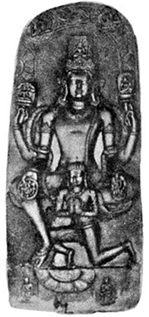
Visnu seated on Garuda holds a chakra with Chakrapurusa in the lower right hand and in the lower left hand a short gada with Gadadevi, and each of the two upper hands holds a lotus; on the lotus of the right hand sits Laksmi lustrated by two elephants and Sarasvati playing an early form of vina is on the lotus of the left hand.
But what is most striking is the presence of a small, four-armed figure seated in cross-legged position in meditation and holding two attributes, perhaps shankha and chakra. It is difficult to explain this iconographic situation. It does not appear to be an image with any Buddhist affiliation. Most probably it is an esoteric image of deep metaphysical significance. In the final stage of the development of Visnu images the two ayudha-purusas (attributes)—Shankhapurusa and Chakrapurusa — are shown with Laksmi and Sarasvati. (Fig-6).
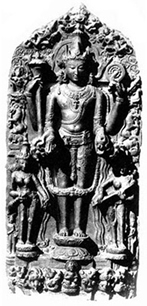
Besides Visnu, a few interesting images of his various incarnations (avataras) originated in Bengal and mention may be made of the Fish (Matsya) from Vajrayogini, Munshiganj, now in BNM. (Fig-7) Tortoise (Kurma) from Mahanad (Hughli), now in IM, Calcutta; Boar (Varaha) from Silimpur (Bogra), now in VRM, Rajshahi; Man-Lion (Narasingha) from vikramapura, Munshiganj, now in BNM; Dwarf (Vamana) from Joradeul, Dhaka. Trivikrama-Vamana from Joradeul, Dhaka.
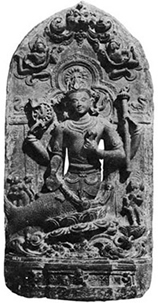
Now in BNM; Parashurama from Ranihati, Dhaka, now in BNM, (Fig-8); Rama (?) from Sonarang, Dhaka, now in VRM; Balarama from Dinajpur, now in VRM, (Fig-9). Of all these incarnations Varaha and Balarama were quite popular in Bengal.
The images of the incarnations were also illustrated around the central Visnu image, as in the two Visnu images now in the Bangladesh National Museum (see Haque, pls 23, 26). There are, no doubt, some differences in the iconographical features of the Visnu images from the Southeast of Bengal compared to those of the North of Bengal; the sacred thread (upavita) of the deity from S-E is short, the jewel Kaustubha is shown on the chest and Garuda is mostly shown in the centre of the pedestal, etc.
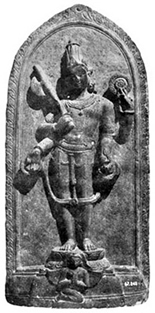
A certain group of Visnu (?) images are unique and they form an iconographic unit by themselves. The deity is shown under a snake canopy like Sankarsana (Balarama), but holding the attributes shankha, chakra, gada and padma, as shown in the image from Surohar (Dinajpur), now in VRM. A two-armed meditative figure is shown on top.
Visnu is attended upon by Shankha and Chakra-Purusa, and the dancing Sudarshana chakra is shown below in a circle on the pedestal. Strangely enough, Garuda is missing in these figures. A damaged, two-armed Visnu from Birol, Dinajpur, now in BNM, shows the two-armed meditative figure at the right, and not on top. The figure stands in abhanga position, and not in the usual samabhanga position.

An eight-armed form of Visnu as Vaikuntha-Vishvarupa is unique. This early image (c 9th century) found at Panchbethair, Tangail, now in BNM, shows the five-headed Visnu (main human head with heads of Matsya, Kurma, Varaha and Singha) in a fighting attitude, accompanied by a female figure holding a quiver and Garuda holding a sword. Ten-armed Visnu images under a snake canopy originated in West Bengal (Burdwan and Medinipur). The Visnu images under a snakecanopy and with a tiny meditative figure above, have wrongly been called Visnu-Lokeshvara.
A twenty-armed Visnu image from North Bengal, damaged at the top, (now in VRM) is of great iconographical interest. Visnu holds in his hands, besides shankha, chakra, gada and padma, other attributes perhaps of the eight Dikpalas. Two pot-bellied seated figures accompany him, and Garuda is shown on the pedestal at the left. The image has been dated in the 11th-12th century.
Shiva The second most important male deity from Bengal was Shiva. Besides the usual Shiva -lingas which were mainly worshipped in the temples and under trees or in an open space, hundreds of Shaiva images were made during the Pala rule. Pre-Pala stone figures of Shiva are rare. At least three Pala rulers were adherents to Shaivism. But before the Palas the Gauda ruler shashanka (7th century) was a devout Shaiva; his coins bear the emblem of a bull, the vehicle of Shiva. Of the Shaiva images from Bengal the special forms of Shiva are those of Uma-Maheshvara, Sadashiva and Nartteshvara (wrongly called Nataraja). A special feature of Shiva from Bengal is that the deity is accompanied by his two consorts, Ganga and Gauri and by two male attendants, Nandi (or Nandin) and Mahakala. Generally Shiva's bull is wrongly called Nandi or Nandin by the art historians. In Bengal (as in Orissa) Shiva is shown mostly urdhvalinga (phallus erectum).
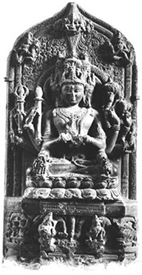
In a 12th century image from Ganeshpur (Rajshahi), now in VRM, a four-armed figure of Shiva is in a very graceful abhanga position, urdhvalinga, and accompanied by Mahakala and Ganga at the right and Gauri and Nandin at the left. Ganga and Gauri are without their respective vahanas. The bull, vehicle of Shiva, is shown on the left at the bottom of the pedestal.
The Sena rulers had a four (five) headed and ten-armed seated image of Shiva called Sadashiva, engraved on their royal seal. But the image was present in Bengal before the Senas. A beautiful inscribed image of Sadashiva (dated in the 14th regnal year of the Pala ruler Gopala IV comes from Bangarh (Rajibpur, Dinajpur), now in IM, Calcutta. In his ten hands the deity holds different attributes. Mahakala, Nandin and the bull (vrsa) are shown on the pedestal. (Fig-10).
The most interesting figures of dancing Shiva generally come from the southeast of Bangladesh. In the inscription the deity is called Nartteshvara. The dancing Shiva images are either ten-or twelve-armed. No dancing image of Shiva was found in North Bengal.

But an inscribed image, the donation of a lady, Chatuhsama was discovered at Maniari (Atrai, Naogaon), now in VRM.
This 11th century dancing Shiva is twelve-armed, playing a vina with the two main hands and is attended by Ganga and Gauri. The deity stands in a cross-legged dancing form (not vaishakha-sthana as in other images from S-E Bengal) on the bull. (Fig-11) In two other similar sculptures, one from Outshahi (Dhaka), and the other from Uttar Baikhal (Dhaka), both in the BNM, Shiva is dancing on the bull in the archer’s position (vaishakhasthanaka). In the latter case, a bull is shown on top with Ganesha, Karttikeya and two other deities.
The other popular image of Shiva is the Uma-Maheshvara-murti; the nomenclature is attested by an inscription.
Maheshvara is either two-or four-armed, Uma is two-armed. Maheshvara’s bull is shown below his right foot, Uma’s lion below her left foot.
The10th-11th century image from Joradeul (Dhaka), now in BNM, is an excellent two-armed Maheshvara holding a small flower in the right hand and pressing the left breast of Uma with the left hand. (Fig-12) Both the deities are shown inside a cave, perhaps indicating Mount Kailasa, and on top in the middle a meditative Shiva is shown with his bull and other deities. An illustration of trixula intertwined with a snake is at the right side of Shiva.
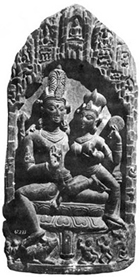
Interesting images from Bengal depicting the marriage of Shiva and Parvati (these and similar North Indian images are wrongly called Kalyanasundara-murti by art historians) are well-known, and of these the 12th century Sankarbandha (Dhaka) image, now in BNM, is quite spectacular, depicting the bride and bridegroom and various other deities on the back-plate. Perhaps a meditative image of Shiva is shown at the extreme top.
The two mounts of the deities, viz. the bull and the lion, are also present.
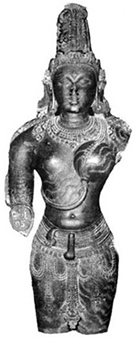
An excellent image of the Androgyne form of Shiva, called Ardhanarishvara, ie half of Shiva and half of Parvati, from Purapara (Dhaka), now in VRM. This is a beautiful image, the only one of its kind from Bengal, worked out in detail on the blackstone and is dated in the 12th century. (Fig-13)
Besides the friendly (saumya) type of images several terrifying (ugra) forms of Shiva are found in Bengal and of these Bhairava, Batuka (dwarf)-Bhairava, Aghora, etc need to be mentioned. A ten-armed dancing Bhairava surrounded by the Mother-goddesses is unique and is now at the IM, Calcutta.
A solitary example of a twelve-armed damaged image of Shiva as Andhakasuravadha-murti is from Deul-Talanda (Rajshahi), now in VRM. Shiva holds the elephant-hide and at the same time pierces the demon Andhaka with a trident. The image is dated in the 11th century.
Surya The third important male deity from Bengal is the Surya or the Sun-god. Surya is shown mostly as an independent figure, but also in the group of nine planetary deities or Navagrahas. Quite similar to the Visnu images, the Surya images from southeast of Bangladesh have some iconographic features different from those from the north. The earliest image of the Sun-god is a damged terracotta image from Bogra, now in the Mahasthan Museum. The deity wears a tunic and high boots and a big sword is tied to his waist with a belt. He wears a crown and holds two full-blown lotuses, one in each hand. The image belongs to the Gupta period. Surya is shown standing in samapada position holding two full-blown lotuses, one in each hand, on a chariot drawn by seven horses. He wears a tall crown, ear-rings, necklaces, bangles, armlets and a sacred thread (upavita). What is quite striking is that he wears a cuirass (varma) on the chest and high boots. Originally Surya wore a Sassanian dress. The Brhatsanghita describes the early form of Surya, but is silent about the boots. None of the Puranas has any reference to them.
The next interesting image of the Sun-god is from Deora (Bogra), now in VRM, belonging to the 6th-7th century. The deity is shown riding a chariot drawn by seven horses and holding two full-blown lotuses, one in each hand, and attended upon by fat-bellied Pingala at the right and Dandin at the left. Two arrow-shooting female deities, described later as Usa and Pratyusa, are shown beside Rahu, the charioteer, on the chariot. The Mahisantosh (Dinajpur, Bangladesh) image, now in the State Archaeological Gallery in Calcutta (SAGC), is iconographically a very interesting image. The image (upper portion damaged) is dated in the 15th regnal year of the Pala ruler Mahendrapala (9th century).
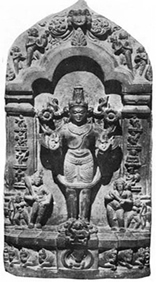
In the later period Surya is accompanied by his two queens, Rajni and Niksubha besides Mahashveta or sometimes by the eight planetary deities (grahas), viz. Soma, Mangala, Budha, Brhaspati, Shukra, Shani, Rahu and Ketu. These may be seen in the beautiful image from Gopinathpur (Bogra), now in VRM. (Fig-14) Sometimes eleven or twelve Adityas (same as Surya) are shown around the Sun-god, (see for example the inscribed Kulkuri image, Faridpur), in BNM. The Bairhatta (Dinajpur, West Bengal) seated and inscribed image of the Sun-god, now in IMC, is a unque figure. The image of Surya with the other eight planetary deities was quite a popular figure in Bengal as is evidenced from several sculptures of this type. Generally Ganesha is shown with the planetary deities.
A few images of Revanta, the son of Surya, riding a horse and accompanied by a dog, were created in Bengal.
From Paharpur a few stone images of the guardian of the directions (dikpalas) came to light; mention may be made of Indra, Agni and Vayu.
Finally one has to take note of several beautiful, isolated images of Garuda, which must have been erected on the top of a pillar (garuda-dhvaja), and the elaborately worked out Makara-heads which served as gargoyle or waterspouts.
Female Divinities Besides various forms of Durga, Gauri or Parvati a few female deities are quite typical of Bengal.
Manasa A unique deity of Bengal is Manasa or the Snake-goddess. In the Sanskrit text, Pratisthalaksana-sarasamuchchaya, however, and in an inscribed bronze image from north Bengal, now in the Linden-Museum at Stuttgart, Germany, the Snake-goddess has been called Svangai or Sungai-bhattarika. It is only in the late brahmavaivarta purana that, for the first time, the deity is called Manasa-devi. Most of the images of the Snake-goddess are late, belonging to the 11th-12th century. The deity is shown, generally two-armed, seated in lalitasana, ie the right leg hangs down and the bent left leg rests on a huge lotus, holding a fruit in the right hand and either a child or a snake in the left hand. Mostly a seven-hooded snake-canopy is shown behind her head and a pot with snakes below her right foot on the pedestal. To her right sits an ascetic with matted hair and to her left a male with a single-hooded snake-canopy, who may be identified as sage Jaratkaru (husband of the goddess) and Vasuki (her brother), respectively. The child with a snake-canopy on her lap may be identified as Astika, her son. An interesting image of the deity holding a snake and surrounded by eight snakes is from Badal, Naogaon, now in VRM, Rajshahi.
A Shiva lingam is shown on top of the deity. Sometimes the Snake-goddess is shown with four hands, of which the 11th century image from Khidrapalli (Bogra), now in VRM, is unique. This image, partially damaged, sits in a cross-legged position (baddha-padmasana) on a huge lotus holding clockwise: a rosary, a snake, a water-pot and a manuscript and is surrounded by ten nagis with folded hands; four nagis with folded hands are shown on the pedestal also. A large pot (manasar ghat) is shown below and a Shiva-lingam on top. (Fig-15) The Malda Museum (West Bengal) also has a unique image of the Snake-goddess (partially damaged), with an elephant shown below the right leg of the goddess (nagendra-vahini).
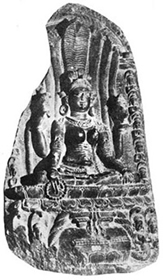
Gauri 'with child Shiva There is a special group of sculptures where a reclining, bejewelled female figure is shown on a cot, her head placed on the left hand and a lily (utpala) held in the right hand, while a child is shown lying close to her. A female attendant shampooes her left foot and two others attend upon her. A Shiva-lingam, Ganesha, Karttikeya and the nine planetary deities are shown on top and various objects for a ritual are shown below.
For some time it was difficult to identify the image and the scene. Bhattasali identified the female figure as Gauri and the child as Shiva, following the marriage story of Shiva with Parvati. Fortunately enough, an inscribed image of the same type was found at Kosham Shahar, Khetlal (Bogra disi.), now in the Mahasthan Museum, referring to the ruling period of Vigrahapala III (c 11th century) and calling the deity Gauri (Fig-16).
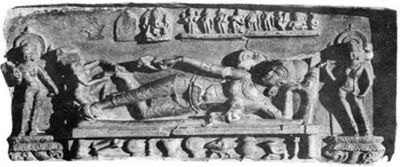
Parvati Another variety of Parvati from Bengal is unique. In this illustration the four-armed Devi is holding clockwise: a fruit, a collyrium stick, a mirror and with the lower left hand on the head of Karttikeya, stands on a lotus with an iguana (godha) below.
Generally Bhattasali and others call this image Gauri, but credit goes to M Th de Mallmann for calling this image Lalita after the description of the Agni-Purana (Fig- 17).
There are two types of the image with an iguana as a mount; one is an ascetic type where the Devi holds clockwise: varada-mudra, aksamala, tridanda and a water-pot; the other is a bridal form mentioned above.
The iguana is present in both cases. Banana plants, lions and antelopes occur in many cases. There are several forms of Parvati from Bengal.
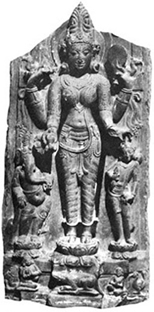
The huge figure (154.9 cm high) from Mandoil, Godagari (Rajshahi), now in VRM, is a unique piece where no mount has been given to the goddess who is shown as an ascetic holding clockwise: varada-mudra, aksamala, tridanda and perhaps a water-jar (damaged) (Fig-18). In this elaborate image banana plants (rambha-vana) are shown on both sides with a lion and Karttikeya at the proper right and an antelope and Ganesha at the proper left. A Shiva-lingam is shown on top at the proper right. This badly mutilated image belongs to c 12th century.
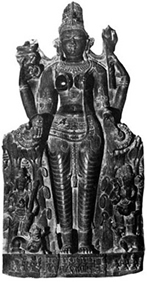
Durga 'There are several images of Durga with four or more arms, seated or standing, with a lion mount. But as mentioned earlier the Durga Mahisasura-mardini was the most popular goddess from Bengal. Mostly the goddess is eight-armed and belongs to the tenth-eleventh century.
The ten-armed form occurs quite late. The Malda Museum, West Bengal possesses several excellent images of eight-armed Durga Mahisasura-mardini.
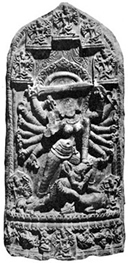
An extraordinary form of Durga Mahisasura-mardini called Navadurga from Porsha (Naogaon), now in VRM, shows besides the central figure, eight other figures all eighteen-armed. Unfortunately the head of the central image is damaged (Fig-19). The image is dated in the 12th century.
Matrkas' Of the Mother-goddesses, Matrkas a rare panel from Jugpur, Godagari, Rajshahi, now in VRM, shows the eight goddesses with four-armed Durga Mahisasura-mardini in the middle (Fig-20). Of the Matrkas Varahi was quite popular. A beautiful c 10th century image of Varahi from Pichli is now in the Maldah Museum.
The deity sits in sukhasana position on a lotus with a pot-bellied, running figure as her mount, holding clockwise in her four hands: a fish, a sword, a shield and a water-jar.

But most popular, was Chamunda or Charchika, befitting the Tantric tradition of Bengal. Several interesting sculptures of the deity, seated or dancing, were found mostly in North Bengal, but the most magnificient figure, is from Rampal, Munshiganj, now in BNM. (Fig-21) The twelve-armed deity holding the elephant skin and various other attributes dances on a corpulent Preta and is surrounded by a host of two-armed dancing figures.
The image is to be dated in the 12th century. Sometimes Chamunda is shown seated on a Preta under a Banyan tree (Vata-vrksa) with severed heads below her feet.
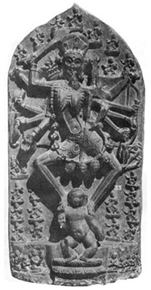
A unique form of this deity, from Dubail, Tanor (Rajshahi), now in VRM, riding on an ass is called Pisitasana (flesh-eater) in the label inscription. The deity holds in her four hands clockwise: a snake, a sword, a shield and a skull-cup.
It is be dated in the 11th century. One should refer to the elegant, two-armed standing Parvati image from Muhammadpur (Comilla), now in IM, Calcutta. The five deities, such as, Ganesha, Brahma, Shiva, Visnu and Karttikeya are shown on top of the back-plate.

The most magnificient image of Gauri or Parvati ever found in Bengal is the so-called Mahamaya image from Kagajipara, Vikrampur (Munshiganj), now in BNM, and undoubtedly a great creation of the Sena period (Fig-22). The four-armed Devi (Gauri?) meditates in front of a huge Shiva-lingam showing dhyana-mudra with the two front hands and holding a rosary in the upper right hand and a manuscript in the upper left hand. The iconography of this image is debated. DC Bhattacharyya called the image Apitakucha.
Lastly, mention should be made of various other female divinities like Sarasvati (seated on a ram), Laksmi (being bathed by two elephants, generally called Gaja-Laksmi), Sasthi, Vagishvari and Ganga.

The huge, though badly mutilated, Ganga image (160 cm high with the Makara) from Deopara (Rajshahi), now in VRM, is a magnificient work of stone sculpture quite similar to the Kagajipara Devi image, and belongs perhaps to the same period (Fig-23).
A graceful Ganga image standing on Makara was found at Bhadrasila (Dinajpur district, West Bengal), now in the SAGC.
Buddhist male images The Master never visited Bengal, but Buddhism flourished all over Bengal for a considerable period. The earliest and most remarkable Buddhist site was known in the Maurya period (3rd century BC) as Pudanagala (Sanskrit: Pundranagara), probably the older name of pundravardhana, identified with mahasthan in the district of Bogra. The second important Buddhist site is Paharpur, now in the district of Naogaon.
The other important Buddhist sites in Bengal were in samatata, modern Comilla and Chittagong districts. The Buddhist pilgrim Seng-chi has recorded vividly the growth and prosperity of Buddhism in Samatata. The ancient city of devaparvata (capital of Samatata) was situated in the modern Lalmai-Mainamati ridge. A large number of Buddhist sculptures and inscribed copperplates were found in the Mainamati area during recent excavations.
Buddha Mention may be made here of the largest sandstone image so far found in Bengal of the Buddha, standing in samapada position on a lotus, showing abhaya-mudra (gesture of assurance) in the right hand and holding the hem of his upper garment with the other. Discovered at a mound called rupban mura, it is now preserved at the Mainamati Museum. (Fig-24) The image is 2.44 m high and belongs to c 7th century. However, the earliest stone Buddha figures are to be dated in the 5th century. The graceful standing, large (107 cm) image of Chunar sandstone showing Buddha in abhaya-mudra is from Bihrail (Rajshahi), now in VRM and is partially damaged.
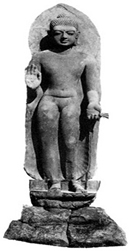
The second early image (6th century) is also standing, but is in varada-mudra (boon-granting gesture). This small image (40 cm) was found in the ruins of bhasu vihara, and is now preserved at the Mahasthan Museum.
In the Paharpur monastery, besides the large burnt bronze image no stone image of the Buddha was found. The only stone image found in the central temple is of Avalokiteshvara, holding a full-blown lotus in the left hand and perhaps varada-mudra in the damaged right hand.
The aureole of the deity is shown with a beautiful lotus design surrounded by beads. Avalokiteshvara is attended upon by Tara (face damaged) at the right and Hayagriva at the left. The three deities stand each on a lotus against an oval-shaped prabhamandala.
Of the Buddha images of the Pala period mention should be made of the huge (122 cm 84 cm) black basalt image from Satimandangi, Bochaganj (Dinajpur, Bangladesh), now in situ. This magnificient c 9th century image is badly mutilated. (Fig-25)
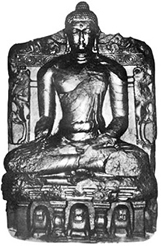
The Buddha sits in bhumisparxa-mudra (earth-touching gesture) on a lion throne (without any lotus) with three lions between the pilasters against the back-rest of the throne. The face of the Buddha with its sublime expression is a great artistic achievement of Bengal.
The next important image is from Ujani (Faridpur), now in BNM. The black stone 10th century image of Buddha sits in bhumisparsha-mudra on a double-petalled lotus on a throne, and three branches of the Bodhi-tree are shown above. Two Vidyadharas each carrying a garland hover against clouds. The image draws special notice because of the fact that in front of the pedestal besides the double vajra (vishva-vajra) Seven Jewels (sapta-ratnas) of a World King (Rajachakravartin) are shown with offerings and the donor (Fig-26). Another great image of Buddha seated in Samadhi-mudra (hands damaged) (102 cm high) also comes from Ujani, now in BNM. The c 10th century black basalt image sits under a trefoil arch above which the Shikhara of a temple (Mahabodhi) with standing Vidyadharas and devotees is shown. A life-size black-basalt Buddha image seated in bhadrasana and showing dharmachakra-mudra was found in the mainamati area. The image, dated in the 10th century, stylistically resembles the Buddha images from Arakan and Myanmar.

The Buddha is shown seated inside a shikhara-type of temple (Mahabodhi at Bodhgaya). A tiny figure of Amoghasiddhi is shown on top. Four seated male deities attend upon him. Below on the pedestal the Sarnath symbol, lions and adorants are shown. Iconographically this is an interesting image, but it is missing.
The final development of the Buddha image is to be noticed in a few elaborate sculptures, one of which is the Sibbati (Bagerhat) image now in the Kamalapur Buddhist monastery, Dhaka, and another is the Betagi, Rangunia (Chittagong) image, now preserved in the Ratnankur Vihar at Betagi.
The Betagi Buddha is attended upon by Maitreya to the right and Avalokiteshvara to the left. The Buddha is shown in bhumisparsha-mudra inside the Mahabodhi temple at Bodhgaya. (Fig-27) Both the images should be dated in the 12th-13th century.
In Mahayana Buddhism, and in Vajrayana or Tantrayana Buddhism five Cosmic or Transcendent Buddhas, viz. Amitabha, Aksobhya, Amoghasiddhi, Ratnasambhava and Vairochana, were introduced. To each of them belong several Bodhisatvas, both male and female.
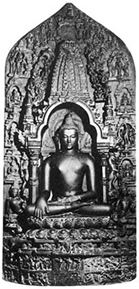
Each Cosmic Buddha (wrongly and popularly called Dhyani-Buddha) is the Lord of a family (kulesha). Shakyamuni who was a supreme Buddha, lost his supremacy in Vajrayana or Tantrayana Buddhism and became subordinate to Aksobhya, one of the five Cosmic Buddhas.

In various stone sculptures from Bengal of a later period he is shown under the Cosmic Buddha like that of a Bodhisatva. Compare for example, the figure of Shakyamuni descending from the Trayastringsha Heaven from Kirtoil, Manda (Naogaon), now in VRM, where the five Cosmic Buddhas are shown above, Aksobhya in the middle, which shows that Aksobhya is the Sire of Shakyamuni. The image belongs to c 11th century. (Fig-28) Similarly the huge standing Buddha, perhaps in abhaya-mudra (damaged) from Dinajpur, now in VRM, is shown under the five Cosmic Buddhas of which Aksobhya is in the middle. The image belongs to c 12th century.
Another Buddha, seated in bhumisparsha-mudra, from Betka (Munsiganj), now in VRM, is shown under Aksobhya in the middle of the five Cosmic Buddhas. The image belongs to c 11th century. (Fig-29) The Cosmic or Transcendent Buddhas were worshipped separately in Bengal. One may compare the bejewelled seated image of Aksobhya from Bharson, Manda (Naogaon), now in VRM. This great image (headless) belongs to the 12th century. The other image of the Transcendent Buddha Ratnasambhava originates from Vikrampur (Munshiganj), and is now in VRM.
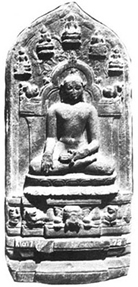
The Buddha is shown seated inside the arch of the Mahabodhi temple holding a jewel (ratna) in his right hand, and a jewel is also shown in his usnisa. Seven jewels (sapta ratnas) are also shown in front of the pedestal. This unique image should belong to the 11th century (Fig-30).
Avalokiteshvara Besides the Buddha a large number of Buddhist images were produced in Bengal, especially in the Pala-Chandra period. For creating the Buddhist images the sculptors followed the well-known Buddhist iconographic text Sadhanamala. Of the Buddhist images the most popular deity was Bodhisatva Avalokiteshvara, who is shown either seated or standing on a lotus, two, four, six-armed or twelve-armed. When two-armed, and this is the common form, he shows varada-mudra in the right hand and holds the stalk of a full-blown lotus in the left hand.
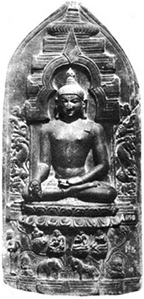
He wears a jata-makuta, upavita and various pieces of jewelry. When seated he sits in the lalitaksepa or lalitasana position, and while standing he stands in abhanga position.
The Sadhanamala describes various forms of Avalokiteshvara and calls the deity Lokanatha, Lokeshvara, etc of which the form Khasarpana-Lokeshvara is quite common. In this form Lokeshvara is accompanied by the deities Tara, Sudhanakumara, Bhrkuti and Hayagriva. Sometimes the ugly ghost (preta) Suchimukha (needle-mouthed) is shown sitting below and begging nectar from the merciful Lord. For a beautiful form of this type see the Mulchar (Munshiganj) image, now in the VRM, dated c 11th century (Fig-31).

The Transcendent Buddha Amitabha (to whose family Avalokiteshvara belongs) is shown twice, once in the jata-makuta of the Bodhisatva and then in the middle of the five transcendent Buddhas above. For a standing image of this type compare the VRM image found at Sonarang (Munshiganj).
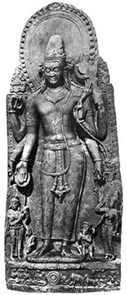
A gracefully standing six-armed image from Namuja (Bogra), now in the Mahasthan Museum, may be described as Sugati-sandarshana-Lokeshvara. The image is quite early (c 9th century). The deity holds in his right hands varada-mudra, ratna and aksamala, and in the left hands tridanda, padma and kalasa. Tara, Bhrkuti and Hayagriva accompany him, and the preta Suchimukha is also shown. (Fig-32) A special image form of Avalokiteshvara called Sadaksari-Lokeshvara representing beautifully the Avalokitesvara-dharani, ong mani-padme hung, was worshipped in North Bengal. An excellent example is the slightly damaged 11th-12th century image from Niyamatpur (Naogaon), now in VRM (Fig-33). The four-armed seated Lokeshvara holds aksamala and padma in the back two hands and shows namaskara-mudra with the front two hands. He is accompanied prominently by Manidhara at the right and Sadaksari Mahavidya at the left. The five Transcendent Buddhas with Amitabha in the middle are shown above. Another image of this deity found at Habibpur (Malda), now in the Malda Museum, belongs to the 12th century.

It is very surprising that although a variety of Avalokiteshvara sitting on a lion called Singhanada-Lokeshvara was quite popular in the Pala period, no image of this type has been found in Bengal. But a parallel image, viz Manjushri sitting on a lion and designated as Manjuvara was quite popular in Bengal. See for example, the Telai (Godagari), now in VRM, a damaged image; Kusumavahana (Niyamatpur, Naogaon), now in BNM; Maheshpur (Patnitala, Rajshahi), now in BNM, a damaged image; Niyamatpur (Naogaon), now in VRM, a damaged image; and Sachar (Matlab, Comilla), now in Mainamati Museum, badly damaged. T
he deity sits in lalitasana on a roaring lion showing dharmacakra-mudra and holding nilotpala with a Prajnaparamita manuscript on it. This type of images belong to the 11th-12th century (Fig-34).
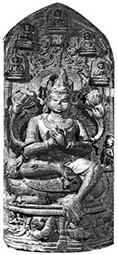
A well-known form of Manjushri known as Arapachana-Manjushri where the deity holds a sword in the right hand and a Prajnaparamita manuscript in the left hand came from Jalkundi, and is now in BNM. Besides the central image four similar but smaller images are shown around the deity together with the four Transcendent Buddhas. The inscribed image belongs to c 12th century.
A very interesting image of Manjushri standing in a graceful abhanga position and attended upon by the two deities Suryaprabha and Chandraprabha was discovered in the village Hatpukuria (Noakhali), and is now in BNM. The image belongs to c 11th century.
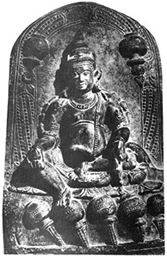
A few excellent seated images of the Buddhist god of riches, Jambhala were found in Bengal, mostly in North Bengal, and of these mention may be made of the image from Bhanpur (Godagari, Rajshahi), now in VRM; and the excellent image from Pabna, now in the Mahasthan Museum (Fig-35). The images belong to c 11th century. Of the other male deities mention may be made of the two-armed deity Heruka from Shubhapur, Devidvar (Comilla), now in BNM.
The deity is dancing on a lotus, wearing a garland of human heads and holding a khatvanga with banner. The image belongs to c 11th century.

The other dancing image of Heruka, but on a human body, is now preserved at the Mainamati Museum (Fig-36). A badly damaged image of the other deity Hevajra dancing in yab yum (united) position with his Prajna came from Paharpur. A rare but very interesting image of the Buddhist deity Namasangiti in his female form has recently been acquired by the Bangladesh National Museum from Vikrampur (Munshiganj). The three-headed and twelve-armed deity sits in a cross-legged position inside a chaitya. This unique image is to be dated c 11th century.
Buddhist Female Deities Of the Buddhist female deities the most prominent is Tara. She is two-armed, showing varada-mudra with the right hand and holding the stalk of a blue lily (nilotpala) in the left hand
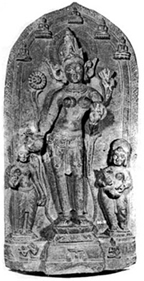
She is generally of green complexion, hence called Shyama or Green Tara, and sometimes she is white and called Shveta or White Tara. Generally she is shown seated in the lalitasana or lalitaksepa position, but she is also shown standing; for example, compare the early image of Tara from Sukhabaspur (Munsiganj), now in BNM; or the later image from Rampal (Munsiganj), now also in BNM, where the gracefully standing deity is attended upon by Ashokakanta-Marichi to her right and Ekajata to her left, and the five Transcendent Buddhas are shown on top with Amoghasiddhi in the middle. Tara belongs to the family of Amoghasiddhi (Fig-37).
Of the seated figures the most well-known, no doubt, is the deity from Sompara, Vajrayogini (Munsiganj), now in BNM. Tara is attended upon by Mahamayuri to the right and Ekajata to the left, and is surrounded by eight seated Taras representing the deliverence from eight great perils (mahabhaya). This image is therefore called Astamahabhaya-Tara.
The image is inscribed and records the name of the donor (Fig -38). Tara is described as Khadiravani Tara (ie belonging to the Acacia Catechu forest) in the Sadhanamala when she is accompanied by the two deities, Ashokakanta-Marichi and Ekajata. After Tara the other popular female Buddhist deity in Bengal was Marichi, who is the Buddhist goddess of dawn and hence is parallel to the Hindu Sun-god, but while the chariot of the Sun-god is drawn by seven horses, the chariot of Marichi is drawn by seven pigs (shukara).

Marichi is of different types; either she has a normal human face, or three faces of which one is a Sow-face, or three faces of which two are Sow-faces. She is two-, six-, eight-, ten- or twelve-armed. A three-headed (left head of a Sow) and eight-armed deity from Panditsar (Pandisar?, Bhederganj, Faridpur) is now in BNM (Fig-39).
The goddess stands in pratyalidha position on a large lotus placed on a chariot drawn by seven pigs with the head of Rahu as the charioteer, inside a Chaitya with Ashoka branches on it. In her eight hands she holds clockwise: needle, arrow, elephant-goad, thunderbolt (damaged), Ashoka-branch, bow, thread and threatening gesture (tarjani mudra), and is accompanied by four Sow-faced companions, Vadali, Vattali, Varali and Varahamukhi. Marichi belongs to the Vairocana family. The image belongs to the 11th century. Similar eight-armed images of Marichi are preserved in the Varendra Research Museum and the Mainamati Museum. Eight-armed Marichi images of stone are common in Bengal.
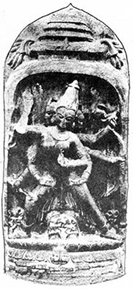
A unique figure of the Buddhist goddess only available from East Bengal is Parnashabari, ie the Tribal woman wearing leaves as her garment.
The pot-bellied deity standing in pratyalidha position trampling down two male figures representing diseases is three-headed and eight-armed. She holds clockwise in her six hands: elephant-goad, arrow, thunder-bolt, leaves, bow and tarjani-mudra. She is accompanied by two figures, one riding a donkey. Below on the pedestal is shown a crawling figure with an elephant head and holding sword and shield. The figure represents no doubt an obstacle or vighna. On top five Transcendent Buddhas are shown with Amoghasiddhi in the middle. The two images, one from Vajrayogini and the other from Naynanda, are now in BNM, and belong to c 11th century (Fig-40).

Of the other Buddhist feamle deities mention should be made of the presence of at least one of the Five Protective (Pancaraksa) deities in eastern Bangladesh.
The cult of these Five Protective deities was prevalent only in this area of Bengal. A three-headed (in relief-sculpture) and eight-armed excellent image (upper portion damaged) of Pratisara or Mahapratisara seated posturously in satvaparyankasana was found in Vikrampur (Munsiganj), and is now in BNM. The deity holds clockwise in her eight hands the following attributes: discus, trident, arrow, sword, bow, thudderbolt, hatchet and noose with tarjani-mudra. It belongs to c 11th century (Fig-41).
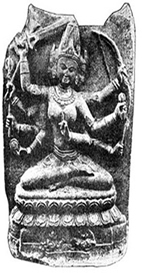
Another dynamic image of the same type was wrongly identified as Bhrkuti-Tara by Bhattasali and unfortunately this identification is widely accepted even today (Fig-42). The deity (upper right corner damaged) originated at Bhavanipur (Munshiganj) and belongs to the early 11th century. In this figure the deity holds in her eight hands the following attributes: trident, sword, thunderbolt, noose and hatchet, the other three attributes are damaged. A crawling elephant-headed two-armed figure of vighna (generally identified as Ganesha) is shown on the pedestal. Because of certain irregular features, viz. prominent teeth in the left face, horrible laughing expression with fangs in the right face, the effigy of the Cosmic Buddha in the tiara and the presence of the elephant-headed figure on the pedestal, it is doubtful if the deity can be identified as Mahapratisara. The figure has recently been identified as an aspect of Marichi.

Jaina images Jainism, as is well-known to all, was prevalent in West Bengal (the area generally known as Radha), as the name of the district Bardhaman (following the name of the last Jaina Tirthankara Vardhamana) bears evidence.
And not only that a large area of West Bengal, ie, the districts of Purulia, Medinipur, Bardhaman and Bankura are scattered with Jaina antiquities, and a large number of stone sculptures were found there, some in situ or brought to the museums.
Some of the large and excellent Tirthankara images are from Bahulara, Harmashra (Bankura, WB) and Mangalkot (Burdwan, WB). North Bengal (north of Bangladesh and West Bengal) was a prosperous place where Jainism flourished. Excellent stone sculptures of the Pala period were found in various districts of North Bengal and of these mention should be made to the well-known Rsabhanatha image from Surohar, Itahar (West Dinajpur), now in VRM (Fig-43).

The lanchhana of Rsabhanatha, the bull (vrsabha), is shown below on the pedestal. The central seated Tirthankara is surrounded by the other twenty-three seated Tirthankaras, all with their individual lanchhana (symbol).

The elaborate image may be dated in the 10th century. A beautiful and interesting standing image of Parshvanatha is preserved in the Dinajpur Museum (Bangladesh). The deity stands in kayotsarga position on a lotus under a seven-hooded snake-canopy. Dikpalas are shown riding animals around him, and the goddess Chakreshvari sits below on the pedestal. The image may be dated c 11th century (Fig-44). Another interesting figure is of the Tirthankara Shantinatha from Mandoil, Godagari, and now in VRM. The deity is surrounded by twenty-four seated Tirthankaras.
The nine planetary deities (Navagrahas) with Ganesha are shown on the pedestal. The image may belong to the 11th century. [Gouriswar Bhattacharya]
Bibliography Benoytosh Bhattacharyya, The Indian Buddhist Iconography, Reprinted. Calcutta, 1968; NK Bhattasali, Iconography of Buddhist and Brahmanical Sculptures in the Dacca Museum, Dacca, 1929, Reprinted, Varanasi, Delhi, 1972; Bhikkhu Sunithananda, Bangladesher Bauddha Bhaskarya (in Bangla), Dhaka, 1999; SK Saraswati, Tantrayana Art : An Album, Calcutta, 1977; RD Banerji, Eastern Indian School of Mediaeval Sculpture, Delhi, 1933, Reprinted New Delhi, 1981; SL Huntington, The Pala-Sena School of Sculptures, Leiden, 1984.
